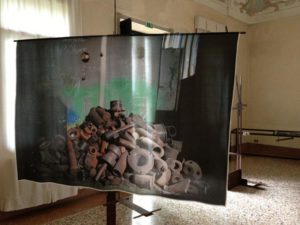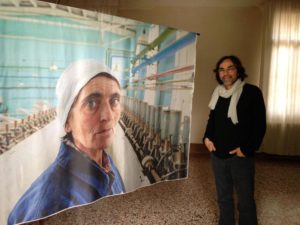ANI Armenian Research Center (Հայկական ուսումնասիրությունների ԱՆԻ հիմնադրամ) received Norayr Kasper‘s book-album “Steel-Lives, Still-Life”.
This book has been published on the occasion of the exhibition “Steel-Lives, Still-Life” by Kasper at the Venice Biennale in 2013.
Steel-Lives, Still-Life consists of five elements; in each one, silk-printed photos relating the post-Soviet Armenian metal industry are supported by rusted steel armatures.
Many of the photos show abandoned factories; some depict former workers at the plants; and others document remnants of the Communist industrial dream as manifested in decaying worker posters and yellowed Lenin portraits.
“This is about a sense of loss,” Kasper said during an interview at the installation. “These people woke up one day in 1989 or so and they were told they were no longer needed on this planet in terms of work, technology, progress…. it is a very painful situation.”
Tensions between light and heavy, and between flexible and static, underscore the exhibition—as does Kasper’s concern with Armenia’s difficulty negotiating such tensions following the fall of the Soviet Union.

Norayr Kasper is a Canadian visual artist of Armenian ancestry. Growing up in Venice and now living in Toronto, Kasper’s sensibilities stem from a diverse cultural background resulting in a rich multidisciplinary art formation. He studied photography and architecture in Venice (IUAV), graduated in film production and cinema, Montreal (Concordia University, 1990).
His work includes art and documentary photography, art films, cinematography of over 30 television and feature films out of which he has shaped a distinct visual signature. His first feature Calendar (in collaboration with director Atom Egoyan), a dialectic between photography and memory, won international recognition among scholars and critics alike.
Over the years he has received many cinematography awards and nominations. Kasper’s expressionistic style emphasizes a rich visual experience where textural elements, lighting, and movement heighten the expressiveness of his varied, cross-disciplinary works.














